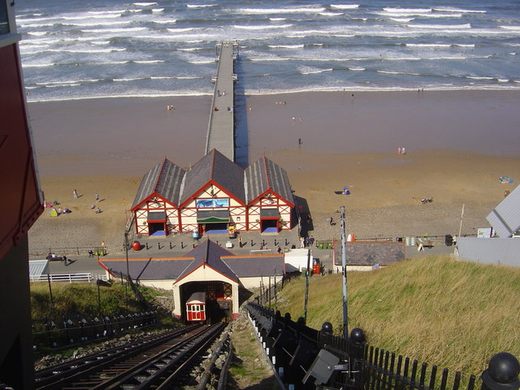Saltburn Cliff Lift
This beautiful example of Victorian engineering is the oldest water-balanced funicular anywhere in the world.
The Saltburn Cliff Lift is a historic funicular railway system located in Saltburn-by-the-Sea in Cleveland, England. It underwent a series of modernisations in the mid-20th century, but recently a process of restoration has returned it to its original glorious Victorian-era state.
An extension of the famous Stockton and Darlington Railway arrived in Saltburn in 1861, prompting a growth in tourism. This encouraged the creation of the Saltburn Pier. However, traveling between the pier and the town at the top of the steep cliffs was difficult. So the Saltburn Pier company decided to build a vertical, wooden “Cliff Hoist.”
Allowing up to 20 people to be lowered in a wooden cage by rope to beach level, it opened in 1870, just over a year after the opening of the pier. The passengers were lowered 120 feet, after water had been added to or taken away from a counterbalance tank.
After the pier company was sold in 1883, the new owners found that the Cliff Hoist had to be condemned due to numerous rotten timbers, and it was finally demolished in late 1883. The owners commissioned a company experienced in funicular construction to build a replacement. The new Cliff Lift (sometimes called the Tramway) was built at a height of 120 feet and a track length of 207 feet, thus creating a 71 percent (1:1.4) incline.
The two 12-person cars are each fitted with a 240-gallon water tank, and run on parallel funicular railway tracks. Double steel wire ropes are attached to both cars, controlled by a brakeman based in the upper station. The car at the top has its water tank filled until the weight of the upper car just exceeds that of the car at the bottom. It then travels down the incline, almost exactly counterbalanced by the other car, which travels to the top, with the brakeman controlling the speed of travel. When the car reaches the bottom, its water is run out, and pumped back up to the top of the cliff.
The original design of the funicular was so good that, beyond maintenance and a bit of refurbishment with the evolution of technology, little has changed technically since 1884. In 1998 the main winding wheel was replaced for the first time (it is kept as a feature at the top of the cliff), along with the installation of a new hydraulic braking system to complement the original mechanical system.
The original cars, capable of seating 10 to 12 passengers, had stained glass windows, very typical of the Victorian era. They were removed when the Cliff Lift was refurbished in 1955, but reinstated in 1991. In 2011, work began to restore the system to its original appearance.


























Follow us on Twitter to get the latest on the world's hidden wonders.
Like us on Facebook to get the latest on the world's hidden wonders.
Follow us on Twitter Like us on Facebook